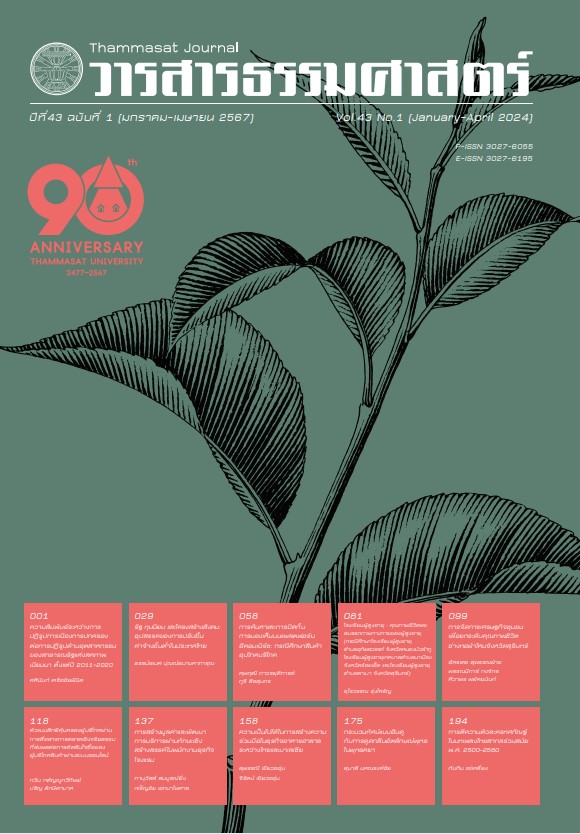The Hindu Paradigm and the Buddhist Identity: A Case Study of the Absorption of Buddhist Identity in Bodhgaya
Main Article Content
Abstract
This research article studies the causes leading to the fall and the disappearance of Buddhism in India during the 3rd-12th century. The result shows that the persecution of monks and the demolition of Buddhist temples at that time were not the main and significant causes. Instead, the significant cause was the devaluation of Buddhist identity resulting from the operation of the Hindu paradigm which supported the caste system, theology, and hierarchical structure of ruling power. The endeavor to overcome tribal intruders from outside since the reign of Gupta had led to the construction of cultural unity in order to establish the identity of mainland residents and promote the ruler’s legitimate power over the land. The Hindu paradigm in its early stage used absorption strategies through methods such as appropriation, inclusion, replacement and persecution. These methods were closely associated with the rise of the Puraṇas and the cults of Vaiṣṇavism and Śaivism. Also, granted by kings and Brahmins, these methods had been exerted at Bodhgaya by both Buddhist and Hindu followers. However, Buddhist followers were not quite successful in applying these strategies and methods while Hindu followers were very successful in doing so.
Article Details
References
แบชัม, เอ แอล. (2559). อินเดียมหัศจรรย์. กาญจนี ละอองศรี (บรรณาธิการแปล). กรุงเทพฯ: มูลนิธิโตโยต้าประเทศไทยและมูลนิธิตำราสังคมศาสตร์และมนุษยศาสตร์.
พระธรรมปิฎก (ป. อ. ปยุตฺฺโต). (2541). จาริกบุญ-จารึกธรรม. กรุงเทพฯ: พิมพ์์สวย. มหาจุฬาลงกรณราชวิทยาลัย (แปล) (2539). พระไตรปิฎกภาษาไทย ฉบับมหาจุฬาลงกรณราชวิทยาลัย เล่มที่ ๑๐, ๑๑. กรุงเทพฯ: มหาจุฬาลงกรณราชวิทยาลัย.
มูลนิธิศึกษาและเผยแพร่พระพุทธศาสนา. (2554). ประวัติพระพุทธโฆษาจารย์์ (วิสุทธิมรรค). Dhammahome https://www.dhammahome.com/webboard/topic18558.html.
ยวาหระลาล เนห์รูู . (2545). พบถิ่นอินเดีย. กรุุณา กุศลาสัย (แปล). กรุงเทพฯ: ศยาม.
สุมาลีี มหณรงค์์ชัย. (2562). ภููมิปัญญาอินเดียโบราณ: ประวัติิศาสตร์์และปรัชญา ทางสายกลางแบบพุทธ พราหมณ์ เชน. กรุงเทพฯ: ศยาม.
Amar, Abhishek S. (2012). Buddhist Responses to Brahmana Challenges in Medieval India: Bodhgaya and Gaya. Journal of the Royal Asiatic Society, 22(1), 155-185.
Bisschop, Peter. (2010). Saivism in the Gupta-Vakataka Age. Journal of the Royal Asiatic Society, 20(4), 477-488.
Capek, Jakub and Loidolt, Sophie. (2021). Phenomenological approaches to personal identity. Phenomenology and the Cognitive Sciences 20, 217-234.
Goyal, Shankar. (1998). Changing Historiography of the Pre-Buddha Period. Annals of the Bhandarkar Oriental Research Institute, 79(1), 29-59.
Lorenzen, David N. (1999). Who Invented Hinduism? Comparative Studies in Society and History, 41(4), 630-659.
Namboodiripad, E. M. S. (1975). Some Problems of Indian History. Social Scientist, 3(9), 14-21.
Omvedt, Gail. (1990). Hinduism and Politics. Economic and Political Weekly, 25(14), 723-729.
Pattanaik, Devdutt. (2018, May 4). In Hindu mythology, Lord Vishnu is associated with economic activities. The Economic Times. www.economictimes.com
Pattanaik, Devdutt. (1999). Shiva: An Introduction. Mumbai: Vakils, Feffer and Simons Ltd.
Pattanaik, Devdutt. (1999). Vishnu: An Introduction. Mumbai: Vakils, Feffer and Simons Ltd.
Shrimali, Krishna Mohan. (2017). The Formation of Religious Identities in India. Social Scientist, 45(5/6), 3-27.
Singh, G. P. (1994). Ancient Indian Religious System in the Times of Manu and Patanjali [200-100 B.C.]. Annals of the Bhandarkar Oriental Research Institute, 75(1), 81-90.
Sokolowski, Robert. (2000). Introduction to Phenomenology. Cambridge: Cambridge University Press.

